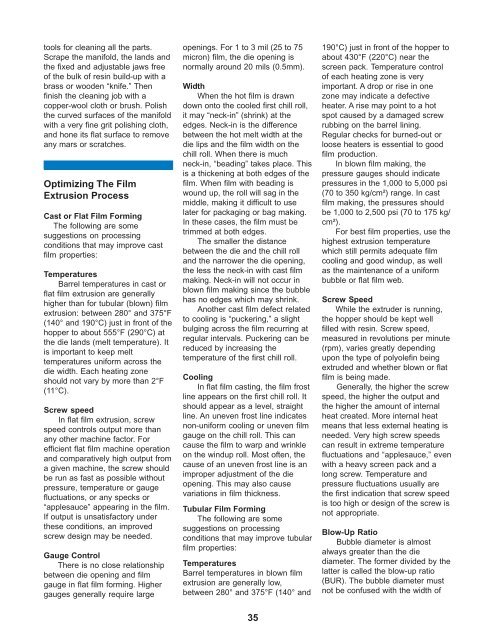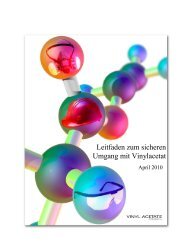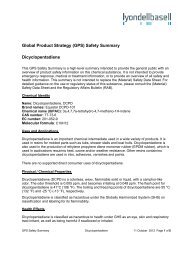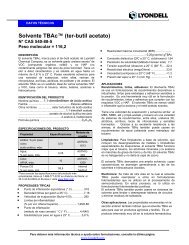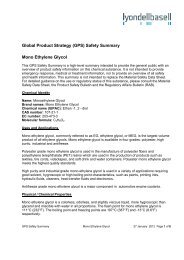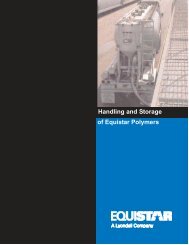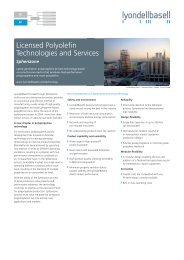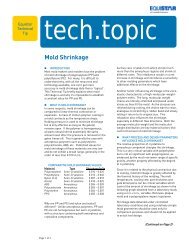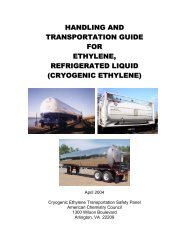Film Extrusion Guide.pmd - LyondellBasell
Film Extrusion Guide.pmd - LyondellBasell
Film Extrusion Guide.pmd - LyondellBasell
Create successful ePaper yourself
Turn your PDF publications into a flip-book with our unique Google optimized e-Paper software.
tools for cleaning all the parts.<br />
Scrape the manifold, the lands and<br />
the fixed and adjustable jaws free<br />
of the bulk of resin build-up with a<br />
brass or wooden “knife.” Then<br />
finish the cleaning job with a<br />
copper-wool cloth or brush. Polish<br />
the curved surfaces of the manifold<br />
with a very fine grit polishing cloth,<br />
and hone its flat surface to remove<br />
any mars or scratches.<br />
Optimizing The <strong>Film</strong><br />
<strong>Extrusion</strong> Process<br />
Cast or Flat <strong>Film</strong> Forming<br />
The following are some<br />
suggestions on processing<br />
conditions that may improve cast<br />
film properties:<br />
Temperatures<br />
Barrel temperatures in cast or<br />
flat film extrusion are generally<br />
higher than for tubular (blown) film<br />
extrusion: between 280° and 375°F<br />
(140° and 190°C) just in front of the<br />
hopper to about 555°F (290°C) at<br />
the die lands (melt temperature). It<br />
is important to keep melt<br />
temperatures uniform across the<br />
die width. Each heating zone<br />
should not vary by more than 2°F<br />
(11°C).<br />
Screw speed<br />
In flat film extrusion, screw<br />
speed controls output more than<br />
any other machine factor. For<br />
efficient flat film machine operation<br />
and comparatively high output from<br />
a given machine, the screw should<br />
be run as fast as possible without<br />
pressure, temperature or gauge<br />
fluctuations, or any specks or<br />
“applesauce” appearing in the film.<br />
If output is unsatisfactory under<br />
these conditions, an improved<br />
screw design may be needed.<br />
Gauge Control<br />
There is no close relationship<br />
between die opening and film<br />
gauge in flat film forming. Higher<br />
gauges generally require large<br />
openings. For 1 to 3 mil (25 to 75<br />
micron) film, the die opening is<br />
normally around 20 mils (0.5mm).<br />
Width<br />
When the hot film is drawn<br />
down onto the cooled first chill roll,<br />
it may “neck-in” (shrink) at the<br />
edges. Neck-in is the difference<br />
between the hot melt width at the<br />
die lips and the film width on the<br />
chill roll. When there is much<br />
neck-in, “beading” takes place. This<br />
is a thickening at both edges of the<br />
film. When film with beading is<br />
wound up, the roll will sag in the<br />
middle, making it difficult to use<br />
later for packaging or bag making.<br />
In these cases, the film must be<br />
trimmed at both edges.<br />
The smaller the distance<br />
between the die and the chill roll<br />
and the narrower the die opening,<br />
the less the neck-in with cast film<br />
making. Neck-in will not occur in<br />
blown film making since the bubble<br />
has no edges which may shrink.<br />
Another cast film defect related<br />
to cooling is “puckering,” a slight<br />
bulging across the film recurring at<br />
regular intervals. Puckering can be<br />
reduced by increasing the<br />
temperature of the first chill roll.<br />
Cooling<br />
In flat film casting, the film frost<br />
line appears on the first chill roll. It<br />
should appear as a level, straight<br />
line. An uneven frost line indicates<br />
non-uniform cooling or uneven film<br />
gauge on the chill roll. This can<br />
cause the film to warp and wrinkle<br />
on the windup roll. Most often, the<br />
cause of an uneven frost line is an<br />
improper adjustment of the die<br />
opening. This may also cause<br />
variations in film thickness.<br />
Tubular <strong>Film</strong> Forming<br />
The following are some<br />
suggestions on processing<br />
conditions that may improve tubular<br />
film properties:<br />
Temperatures<br />
Barrel temperatures in blown film<br />
extrusion are generally low,<br />
between 280° and 375°F (140° and<br />
35<br />
190°C) just in front of the hopper to<br />
about 430°F (220°C) near the<br />
screen pack. Temperature control<br />
of each heating zone is very<br />
important. A drop or rise in one<br />
zone may indicate a defective<br />
heater. A rise may point to a hot<br />
spot caused by a damaged screw<br />
rubbing on the barrel lining.<br />
Regular checks for burned-out or<br />
loose heaters is essential to good<br />
film production.<br />
In blown film making, the<br />
pressure gauges should indicate<br />
pressures in the 1,000 to 5,000 psi<br />
(70 to 350 kg/cm²) range. In cast<br />
film making, the pressures should<br />
be 1,000 to 2,500 psi (70 to 175 kg/<br />
cm²).<br />
For best film properties, use the<br />
highest extrusion temperature<br />
which still permits adequate film<br />
cooling and good windup, as well<br />
as the maintenance of a uniform<br />
bubble or flat film web.<br />
Screw Speed<br />
While the extruder is running,<br />
the hopper should be kept well<br />
filled with resin. Screw speed,<br />
measured in revolutions per minute<br />
(rpm), varies greatly depending<br />
upon the type of polyolefin being<br />
extruded and whether blown or flat<br />
film is being made.<br />
Generally, the higher the screw<br />
speed, the higher the output and<br />
the higher the amount of internal<br />
heat created. More internal heat<br />
means that less external heating is<br />
needed. Very high screw speeds<br />
can result in extreme temperature<br />
fluctuations and “applesauce,” even<br />
with a heavy screen pack and a<br />
long screw. Temperature and<br />
pressure fluctuations usually are<br />
the first indication that screw speed<br />
is too high or design of the screw is<br />
not appropriate.<br />
Blow-Up Ratio<br />
Bubble diameter is almost<br />
always greater than the die<br />
diameter. The former divided by the<br />
latter is called the blow-up ratio<br />
(BUR). The bubble diameter must<br />
not be confused with the width of


